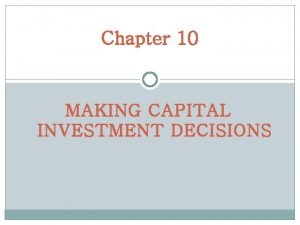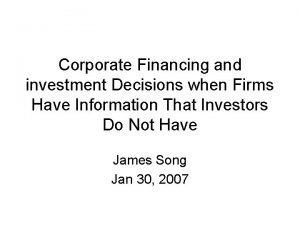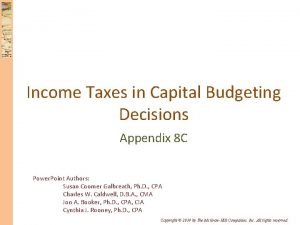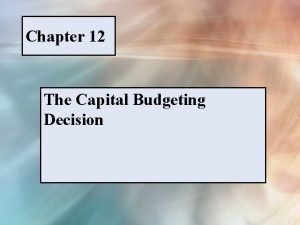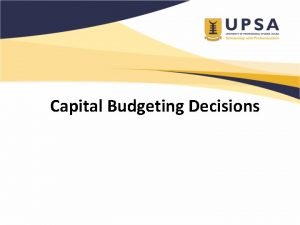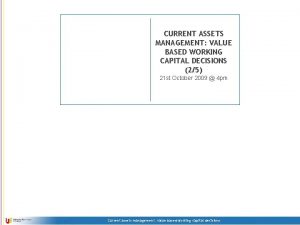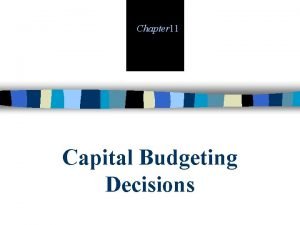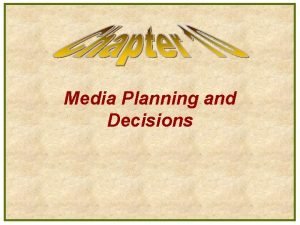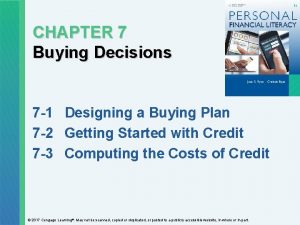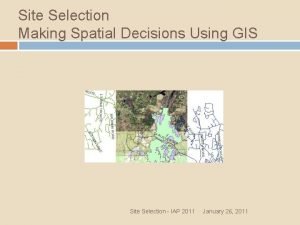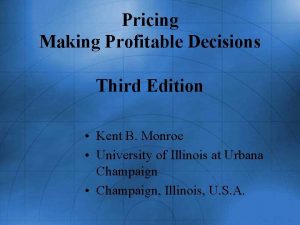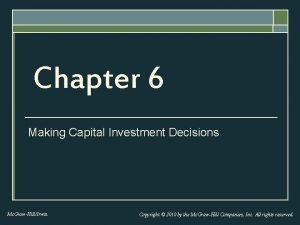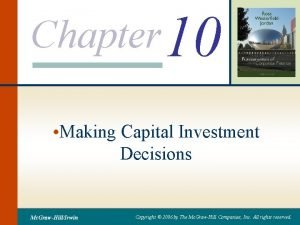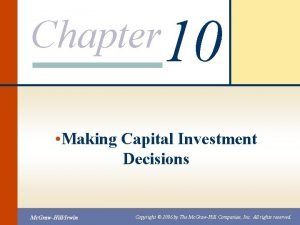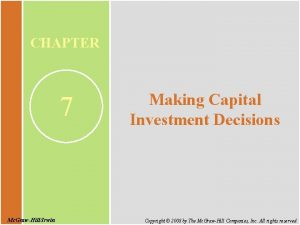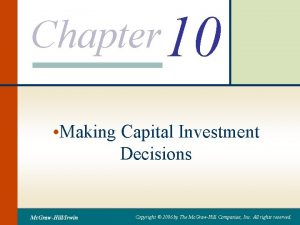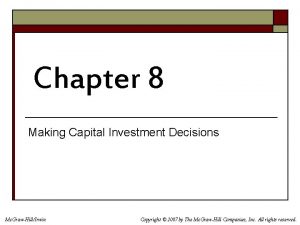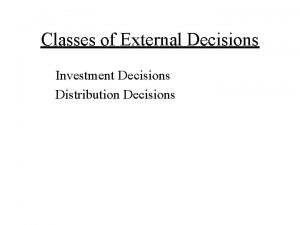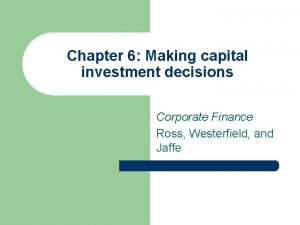Making Capital Investment Decisions Chapter 9 Mc GrawHillIrwin

























- Slides: 25

Making Capital Investment Decisions Chapter 9 Mc. Graw-Hill/Irwin © 2004 The Mc. Graw-Hill Companies, Inc. All rights reserved

Prepare for Capital Budgeting Part 2: Understand financial statement & cash flow C 2 -Identify cash flow from financial statement C 3 -Financial statement and comparison Part 3: Valuation of future cash flow C 4 -Basic concepts C 5 -More exercise Part 4: Valuing stocks and bonds C 6 -Bond C 7 -Stock Part 5: Capital budgeting C 8 -NPV and other investment criteria 1 Mc. Graw-Hill/Irwin © 2004 The Mc. Graw-Hill Companies, Inc. All rights reserved

Chapter Outline 1. 2. 3. 4. 5. Analyze A Project’s Projected Cash Flows Based on Pro Forma Financial Statements Relevant Cash Flows Tax Shield Approach Scenario and Sensitivity Analyses Managerial Options 2 Mc. Graw-Hill/Irwin © 2004 The Mc. Graw-Hill Companies, Inc. All rights reserved

1. Pro Forma Statements and Cash Flow n Capital budgeting relies heavily on pro forma accounting statements, particularly income statements n Computing cash flows – refresher Operating Cash Flow (OCF) = EBIT + depreciation – taxes n Cash Flow From Assets (CFFA) = OCF – net capital spending (NCS) – changes in NWC n 3 Mc. Graw-Hill/Irwin © 2004 The Mc. Graw-Hill Companies, Inc. All rights reserved

Cash Flow Illustration 4 Mc. Graw-Hill/Irwin © 2004 The Mc. Graw-Hill Companies, Inc. All rights reserved

Table 9. 1 Pro Forma Income Statement Sales (50, 000 units at $4. 00/unit) $200, 000 Variable Costs ($2. 50/unit) 125, 000 Gross profit $ 75, 000 Fixed costs 12, 000 Depreciation ($90, 000 / 3) 30, 000 EBIT $ 33, 000 Taxes (34%) 11, 220 Net Income $ 21, 780 5 Mc. Graw-Hill/Irwin © 2004 The Mc. Graw-Hill Companies, Inc. All rights reserved

Calculating OCF n Operating Cash Flow (OCF) = EBIT + depreciation – taxes n OCF=33, 000+30, 000 -11, 220=51, 780 6 Mc. Graw-Hill/Irwin © 2004 The Mc. Graw-Hill Companies, Inc. All rights reserved

Table 9. 2 Projected Capital Requirements Year 0 NWC Net Fixed Assets 1 2 3 $20, 000 90, 000 60, 000 30, 000 0 7 Mc. Graw-Hill/Irwin © 2004 The Mc. Graw-Hill Companies, Inc. All rights reserved

Cash Flow Illustration Year 0 OCF 1 2 $51, 780 Change in NWC Capital Spending -$20, 000 CFFA -$110, 00 $51, 780 3 $51, 780 20, 000 -$90, 000 $51, 780 $71, 780 8 Mc. Graw-Hill/Irwin © 2004 The Mc. Graw-Hill Companies, Inc. All rights reserved

Cash Flow Illustration n Now that we have the cash flows, we can apply the techniques that we learned in chapter 8 n Enter the cash flows into the calculator and compute NPV when I/Y=20% n NPV = 10, 648 n Should we accept or reject the project? 9 Mc. Graw-Hill/Irwin © 2004 The Mc. Graw-Hill Companies, Inc. All rights reserved

2. Relevant Cash Flows n Stand-alone n principle The cash flows that should be included in a capital budgeting analysis are those that will only occur if the project is accepted n These cash flows are called incremental cash flows n The stand-alone principle, which simply focuses on incremental cash flows, allows us to analyze each project in isolation from the firm simply 10 Mc. Graw-Hill/Irwin © 2004 The Mc. Graw-Hill Companies, Inc. All rights reserved

Asking the Right Question n You should always ask yourself “Will this cash flow occur ONLY if we accept the project? ” If the answer is “yes”, it should be included in the analysis because it is incremental n If the answer is “no”, it should not be included in the analysis because it will occur anyway n If the answer is “part of it”, then we should include the part that occurs because of the project n 11 Mc. Graw-Hill/Irwin © 2004 The Mc. Graw-Hill Companies, Inc. All rights reserved

Common Types of Cash Flows n Opportunity n Side costs – costs of lost options effects Positive side effects – benefits to other projects n Negative side effects – costs to other projects n n Changes in net working capital n Taxes n Sunk costs – costs that have accrued in the past 12 Mc. Graw-Hill/Irwin © 2004 The Mc. Graw-Hill Companies, Inc. All rights reserved

3. After-tax Salvage n If the salvage value is different from the book value of the asset, then there is a tax effect n Book value = initial cost – accumulated depreciation n After-tax salvage = salvage – T*(salvage – book value) 13 Mc. Graw-Hill/Irwin © 2004 The Mc. Graw-Hill Companies, Inc. All rights reserved

Example n Consider the previous example, if the company sells out the equipment at $10, 000 when the project is done and the company’s marginal tax rate is 40%. What is the after-tax salvage? n After-tax salvage = salvage – T*(salvage – book value) n After-tax salvage=10, 000 -. 4*(10, 000 -0)=6, 000 14 Mc. Graw-Hill/Irwin © 2004 The Mc. Graw-Hill Companies, Inc. All rights reserved

Cash Flow Illustration Year 0 OCF 1 2 $51, 780 3 $51, 780 Change in NWC Capital Spending -$20, 000 -$90, 000 6, 000 CFFA -$110, 00 $51, 780 $77, 780 15 Mc. Graw-Hill/Irwin © 2004 The Mc. Graw-Hill Companies, Inc. All rights reserved

4. Scenario Analysis n What happens to the NPV under different cash flows scenarios? n At the very least look at: Best case – revenues are high and costs are low n Worst case – revenues are low and costs are high n Measure of the range of possible outcomes n n Best case and worst case are not necessarily probable, they can still be possible 16 Mc. Graw-Hill/Irwin © 2004 The Mc. Graw-Hill Companies, Inc. All rights reserved

Sensitivity Analysis n What happens to NPV when we vary one variable at a time n This is a subset of scenario analysis where we are looking at the effect of specific variables on NPV n The greater the volatility in NPV in relation to a specific variable, the larger the forecasting risk associated with that variable and the more attention we want to pay to its estimation 17 Mc. Graw-Hill/Irwin © 2004 The Mc. Graw-Hill Companies, Inc. All rights reserved

New Project Example n Consider the project discussed in the text n The initial cost is $200, 000 and the project has a 5 -year life. There is no salvage. Depreciation is straight-line, the required return is 12% and the tax rate is 34% n The base case NPV is 15, 567 18 Mc. Graw-Hill/Irwin © 2004 The Mc. Graw-Hill Companies, Inc. All rights reserved

Summary of Scenario Analysis Scenario Net Income Cash Flow NPV IRR Base case 19, 800 59, 800 15, 567 15. 1% Worst Case 24, 490 -111, 719 -14. 4% 99, 730 159, 504 40. 9% -15, 510 Best Case 59, 730 19 Mc. Graw-Hill/Irwin © 2004 The Mc. Graw-Hill Companies, Inc. All rights reserved

Summary of Sensitivity Analysis Scenario Unit Sales Cash Flow NPV IRR Base case 6000 59, 800 15, 567 15. 1% Worst case 5500 53, 200 -8, 226 10. 3% Best case 6500 66, 400 39, 357 19. 7% 20 Mc. Graw-Hill/Irwin © 2004 The Mc. Graw-Hill Companies, Inc. All rights reserved

5. Managerial Options n Capital budgeting projects often provide other options that we have not yet considered Contingency planning (“what if ” option) n Option to expand n Option to abandon n Option to wait n Strategic options (“testing” project) n 21 Mc. Graw-Hill/Irwin © 2004 The Mc. Graw-Hill Companies, Inc. All rights reserved

Capital Rationing n Capital rationing occurs when a firm or division has limited resources Soft rationing – the limited resources are temporary, often self-imposed n Hard rationing – capital will never be available for this project n n The profitability index is a useful tool when faced with soft rationing 22 Mc. Graw-Hill/Irwin © 2004 The Mc. Graw-Hill Companies, Inc. All rights reserved

Review Questions 1. Know how to calculate OCF based on pro forma statements to find out NPV of a project 2. How do we determine if cash flows are relevant to the capital budgeting decision? Is a sunk cost a relevant cash flow for project evaluation? Is an opportunity cost a relevant cash flow for project evaluation? Are benefits and costs to other project, and taxes relevant cash flows for project evaluation? 23 Mc. Graw-Hill/Irwin © 2004 The Mc. Graw-Hill Companies, Inc. All rights reserved

Review Questions (cont. . ) 3. Know how to calculate after-tax salvage. 4. What is scenario analysis and what is sensitivity analysis? 5. What are the major types of typical managerial option? What is capital rationing? 24 Mc. Graw-Hill/Irwin © 2004 The Mc. Graw-Hill Companies, Inc. All rights reserved
 Interest tax shield formula
Interest tax shield formula Chapter 10 making capital investment decisions
Chapter 10 making capital investment decisions Making capital investment decisions
Making capital investment decisions Making capital investment decisions
Making capital investment decisions Making capital investment decisions
Making capital investment decisions Image making meaning
Image making meaning Screening decisions and preference decisions
Screening decisions and preference decisions Corporate financing and investment decisions
Corporate financing and investment decisions Fixed investment and inventory investment
Fixed investment and inventory investment Tax shield
Tax shield Advantages of capital budgeting
Advantages of capital budgeting Capital budgeting decisions ppt
Capital budgeting decisions ppt Working capital management
Working capital management Nature of capital budgeting decisions
Nature of capital budgeting decisions Working capital decisions
Working capital decisions Typical capital budgeting decisions include
Typical capital budgeting decisions include Payback chapter 14
Payback chapter 14 Gross rating points
Gross rating points An organized method for making good buying decisions
An organized method for making good buying decisions Designing a buying plan
Designing a buying plan Making spatial decisions using gis
Making spatial decisions using gis Making healthy decisions unit test
Making healthy decisions unit test Setting health goals and making responsible decisions
Setting health goals and making responsible decisions Arithmetic sequence in making decisions
Arithmetic sequence in making decisions Pricing: making profitable decisions
Pricing: making profitable decisions Making wise decisions meaning
Making wise decisions meaning

